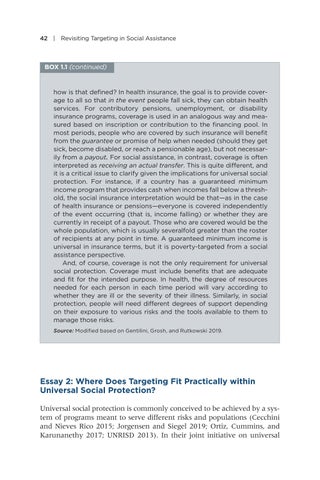42 | Revisiting Targeting in Social Assistance
BOX 1.1 (continued)
how is that defined? In health insurance, the goal is to provide coverage to all so that in the event people fall sick, they can obtain health services. For contributory p ensions, unemployment, or disability insurance programs, coverage is used in an analogous way and measured based on inscription or contribution to the financing pool. In most periods, people who are covered by such insurance will benefit from the guarantee or promise of help when needed (should they get sick, become disabled, or reach a pensionable age), but not necessarily from a payout. For social assistance, in contrast, coverage is often interpreted as receiving an actual transfer. This is quite different, and it is a critical issue to clarify given the implications for universal social protection. For instance, if a country has a guaranteed minimum income program that provides cash when incomes fall below a threshold, the social insurance interpretation would be that—as in the case of health insurance or pensions—everyone is covered independently of the event occurring (that is, income falling) or whether they are currently in receipt of a payout. Those who are covered would be the whole population, which is usually severalfold greater than the roster of recipients at any point in time. A guaranteed minimum income is universal in insurance terms, but it is poverty-targeted from a social assistance perspective. And, of course, coverage is not the only requirement for universal social protection. Coverage must include benefits that are adequate and fit for the intended purpose. In health, the degree of resources needed for each person in each time period will vary according to whether they are ill or the severity of their illness. Similarly, in social protection, people will need different degrees of support depending on their exposure to various risks and the tools available to them to manage those risks. Source: Modified based on Gentilini, Grosh, and Rutkowski 2019.
Essay 2: Where Does Targeting Fit Practically within Universal Social Protection? Universal social protection is commonly conceived to be achieved by a system of programs meant to serve different risks and populations (Cecchini and Nieves Rico 2015; Jorgensen and Siegel 2019; Ortiz, Cummins, and Karunanethy 2017; UNRISD 2013). In their joint initiative on universal


